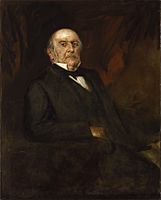Third Gladstone ministry facts for kids
Quick facts for kids Third Gladstone ministry |
|
|---|---|
| February–July 1886 | |

Gladstone (1886)
|
|
| Date formed | 1 February 1886 |
| Date dissolved | 20 July 1886 |
| People and organisations | |
| Monarch | Victoria |
| Prime Minister | William Gladstone |
| Total no. of members | 68 appointments |
| Member party | Liberal Party |
| Status in legislature | Minority |
| Opposition party | Conservative Party |
| Opposition leaders |
|
| History | |
| Election(s) | 1885 general election |
| Outgoing election | 1886 general election |
| Legislature term(s) |
23rd UK Parliament
lost a vote of confidence |
| Predecessor | First Salisbury ministry |
| Successor | Second Salisbury ministry |
The third Gladstone ministry was a very short period when William Gladstone was the Prime Minister of the United Kingdom. He was part of the Liberal Party. Queen Victoria asked him to be Prime Minister again. This government lasted only five months, from February to July 1886.
Contents
How the Government Was Formed
In February 1886, the Liberal Party, led by William Gladstone, came into power. They won with help from Irish politicians. They defeated the Conservative government, which was led by Lord Salisbury. This new government became one of the shortest in British history.
Gladstone was 76 years old when he became Prime Minister for the third time. Many important people joined his team:
- Sir William Vernon Harcourt became the person in charge of the country's money, called the Chancellor of the Exchequer.
- Hugh Childers became the Home Secretary, looking after law and order inside the country.
- The Earl of Rosebery, who would later become Prime Minister, was the Foreign Secretary. He handled relationships with other countries.
- Sir Farrer Herschell became the Lord Chancellor, a top legal role.
- Lord Granville became the Secretary of State for the Colonies, dealing with Britain's colonies around the world.
- Lord Kimberley was the Secretary of State for India.
- Joseph Chamberlain was put in charge of local government.
- Henry Campbell-Bannerman, another future Prime Minister, became the Secretary of State for War.
- John Morley got his first government job as the main official for Ireland, called the Chief Secretary for Ireland.
The Big Idea: Irish Home Rule
This government is mostly remembered for Gladstone's plan to give Ireland more control over its own affairs. This idea was called the Home Rule Bill for Ireland. It meant Ireland would have its own parliament for local matters, but still be part of the United Kingdom.
However, many people in Britain disagreed with this plan. On June 8, the bill was voted on and lost by a small number of votes. A lot of Liberal Members of Parliament (MPs) even voted against their own party's plan.
Because the bill failed, Parliament was closed down on June 26. The issue of Irish Home Rule caused a big split in the Liberal Party. Some members, like Lord Hartington and Joseph Chamberlain, left the party. They formed a new group called the Liberal Unionists. They did not want Ireland to have Home Rule.
What Happened Next
After the Home Rule Bill failed, a new election was held in July 1886. The Conservative Party, with the help of the new Liberal Unionists, won the election. Lord Salisbury became Prime Minister again.
The Liberal Party did not return to power until 1892. That's when William Gladstone became Prime Minister for a fourth time.
Key People in the Government
This section lists the main ministers in Gladstone's government from February to August 1886.
| Portfolio | Minister | Took office | Left office |
|---|---|---|---|
|
William Gladstone* | 1 February 1886 | 20 July 1886 |
| Lord Chancellor | The Lord Herschell | 6 February 1886 | 3 August 1886 |
| Lord President of the Council | The Earl Spencer | 6 February 1886 | 3 August 1886 |
| Secretary of State for the Home Department | Hugh Childers | 6 February 1886 | 3 August 1886 |
| Secretary of State for Foreign Affairs | The Earl of Rosebery | 6 February 1886 | 3 August 1886 |
| The Earl Granville | 6 February 1886 | 3 August 1886 | |
| Secretary of State for War | Henry Campbell-Bannerman | 6 February 1886 | 3 August 1886 |
| Secretary of State for India | The Earl of Kimberley | 6 February 1886 | 3 August 1886 |
| Chancellor of the Exchequer | Sir William Harcourt | 6 February 1886 | 3 August 1886 |
| First Lord of the Admiralty | The Marquess of Ripon | 6 February 1886 | 3 August 1886 |
| President of the Board of Trade | A. J. Mundella | 6 February 1886 | 3 August 1886 |
| President of the Local Government Board | Joseph Chamberlain | 6 February 1886 | 3 April 1886 |
| James Stansfeld | 3 April 1886 | 3 August 1886 | |
| Chief Secretary for Ireland | John Morley | 6 February 1886 | 3 August 1886 |
| Secretary for Scotland | Sir George Trevelyan | 6 February 1886 | 3 April 1886 |
Changes in the Cabinet
In April 1886, James Stansfeld took over from Joseph Chamberlain at the Local Government Board. George Otto Trevelyan also left the Cabinet around this time.


